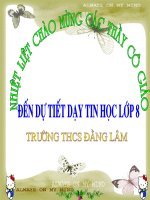WholeGeo on PPT
Bạn đang xem bản rút gọn của tài liệu. Xem và tải ngay bản đầy đủ của tài liệu tại đây (2.5 MB, 1,106 trang )
Earth Science Summaries
by
Edward J. Tarbuck
Frederick K. Lutgens
SOURCE:
/>
Topics:
Chapter 1: Introduction to Earth Science
Chapter 2: Minerals: Building Blocks of Rocks
Chapter 3: Rocks: Materials of the Solid Earth
Chapter 4: Weathering, Soil, and Mass Wasting
Chapter 5: Running Water and Groundwater
Chapter 6: Glaciers, Deserts, and Wind
Chapter 7: Earthquakes and Earth's Interior
Chapter 8: Plate Tectonics
Chapter 9: Volcanoes and Other Igneous Activity
Chapter 10: Mountain Building
Chapter 11: Geologic Time
Chapter 12: Earth's History: A Brief SummaryChapter 13: The Ocean Floor
Chapter 14: Ocean Water and Ocean Life
Chapter 15: The Dynamic Ocean
Chapter 16: The Atmosphere: Composition, Structure, and Temperature
Chapter 17: Moisture, Clouds, and Precipitation
Chapter 18: Air Pressure and Wind
Chapter 19: Weather Patterns and Severe StormsChapter 20: Climate
Chapter 21: Origin of Modern Astronomy
Chapter 22: Touring Our Solar System
Chapter 23: Light, Astronomical Observations, and the Sun
Chapter 24: Beyond Our Solar System
Chapter 1:
Introduction to Earth
Science
Earth science is the name
for all the sciences that
collectively seek to
understand Earth and its
neighbors in space.
It includes geology,
oceanography,
meteorology, and
astronomy.
Geology is traditionally
divided into two broad
areas—physical and
historical.
Environment refers to
everything that
surrounds and
influences an organism.
These influences can be
biological, social, or
physical.
When applied to Earth
science today, the term
environmental is usually
reserved for those
aspects that focus on the
relationships between
people and the natural
environment.
Resources are an important
environmental concern.
The two broad categories of
resources are (1)
renewable, which means
that they can be
replenished over
relatively short time
spans, and (2)
nonrenewable.
As population grows, the
demand for resources
expands as well.
Environmental problems
can be local, regional, or
global.
Human-induced problems
include urban air
pollution, acid rain,
ozone depletion, and
global warming.
Natural hazards include
earthquakes, landslides,
floods, and hurricanes.
As world population grows,
pressures on the
environment also
increase.
All science is based on the
assumption that the
natural world behaves in
a consistent and
predictable manner.
The process by which
scientists gather facts
through observation and
careful measurement
and formulate scientific
hypotheses and theories
is called the scientific
method.
To determine what is occurring
in the natural world,
scientists often (1) collect
facts, (2) develop a
scientific hypothesis, (3)
construct experiments to
validate the hypothesis,
and (4) accept, modify, or
reject the hypothesis on the
basis of extensive testing.
Other discoveries represent
purely theoretical ideas
that have stood up to
extensive examination.
Still other scientific
advancements have
been made when a
totally unexpected
happening occurred
during an experiment.
One of the challenges for
those who study Earth is
the great variety of space
and time scales.
The geologic time scale
subdivides the 4.5 billion
years of Earth history
into various units.
The nebular hypothesis
describes the formation
of the solar system.
The planets and Sun began
forming about 5 billion
years ago from a large
cloud of dust and gases.









